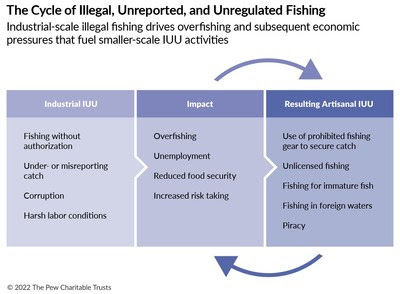Illegal fishing, overfishing and climate change contribute to high death rates in one of world’s most dangerous professions
WASHINGTON, Nov. 3, 2022 /PRNewswire/ — More than 100,000 fishing-related deaths occur each year, a new study finds. Nearly 300 fishers die each day—a much higher estimate than all previous assessments—according to research from the FISH Safety Foundation (FSF) commissioned by The Pew Charitable Trusts.

The significant death toll disproportionately affects low-income fishers—including children forced into labor—and is predominantly driven by dangerous working conditions and unsafe vessels.
The FSF identified several factors responsible for fisher mortality, including poverty; geopolitical conflict; overfishing; illegal, unreported and unregulated (IUU) fishing; and climate change. IUU is a significant driver, particularly as the demand for fish protein increases globally. Industrial illegal operators cut corners and ignore safety rules while contributing to the overexploitation of highly profitable catch. This in turn drives what has been identified as “IUU by necessity,” in which small-scale, artisanal fishers are driven to break rules or take part in unregulated, dangerous activities as it becomes more difficult to find fish. These conditions are exacerbated by climate change and the changing distribution of fish stocks.
“While fishing can be inherently risky, the harsh reality is that many of these deaths were and are avoidable. With 3 billion people reliant on seafood and the demand expected to rise, stronger policies are urgently needed to keep fishers safe, including ones that address the true drivers of these deaths,” said Peter Horn, a project director with Pew’s international fisheries project, which is focused on ending and preventing illegal fishing.
Eric Holliday, chief executive of FSF, said, “It has been widely speculated that fisher mortality estimates have undercounted and hidden the danger of fishing. Our analysis is the first of its kind and conclusively shows that a lack of transparency in the fishing industry endangers lives by obscuring the full picture of what occurs on vessels or at fishing grounds, making it difficult for governments to set effective policies to improve safety. While we may never be able to pinpoint an exact number of fisher deaths, this should serve as a wake-up call to governments, telling them that in order to save lives, urgent action—informed by better reporting and sharing of mortality data—is needed.”
By reviewing publicly available data and by cross-referencing it with investigative journalism and news articles, social media, and private communications with government officials and others, the study authors were able to provide the most complete picture to date of the number of fishing-related fatalities worldwide.
But even with all these available tools, data gaps remain, and the total number is nearly impossible to quantify. Insufficient and inaccurate data has made it difficult for decision makers to implement necessary policy changes that ensure the safety of industrial and subsistence fishers at international, state and local levels.
Based on the study results, Pew urges action on multiple fronts. Domestically, more needs to be done to implement fisher safety measures and address key drivers. Given the disproportionate levels of fatality in low-income communities, financial support and capacity building are urgently needed. Internationally, improved data collection, transparency and information-sharing efforts will help governing bodies better understand the problems fishers face, more accurately quantify additional risks presented by IUU fishing and adopt policies for stronger vessel safety measures.
There are also existing regulatory frameworks available that are designed to stop illegal fishing and protect fishers. Specifically, countries should ratify and implement the Cape Town Agreement, adopted by the International Maritime Organization in 2012, which sets safety standards for the construction and design of fishing vessels; implement the FAO Agreement on Port State Measures, which works to prevent illegally caught fish from entering the seafood supply chain; and continue implementation of the 2007 ILO Work in Fishing Convention C188, which sets standards for living conditions onboard vessels at sea. Member States of regional fishery management organizations should also set clear policies that strengthen efforts to fight IUU fishing and overfishing.
“Fortunately, there are a number of tools available that can help stop industrial IUU and overfishing and improve safety concerns in one of the world’s most dangerous professions,” Horn added. “While not addressing all the issues, they clearly demonstrate intent to tackle this problem. International authorities must also prioritize counting these deaths. Only with a clearer picture of what is happening on the water can officials know when—and where—stronger action is needed. This study should be a clarion call to international authorities, national governments and fisheries managers around the globe, to be accountable for addressing their piece of the problem. Fishers should no longer be dying in the dark, and governments can no longer ignore the severe human injustices and inequities resulting from insufficient action on IUU fishing, overfishing and climate change.”
Contact: Leah Weiser, lweiser@pewtrusts.org, +1-202-591-6761
Photo – https://mma.prnewswire.com/

